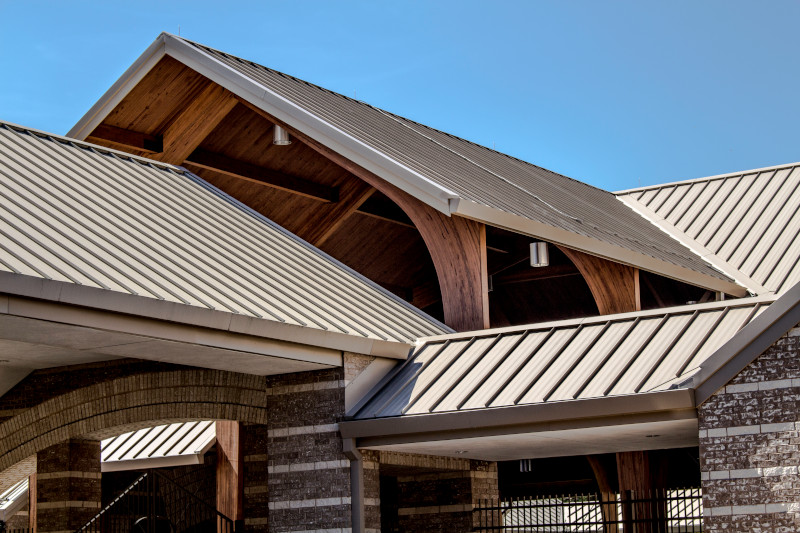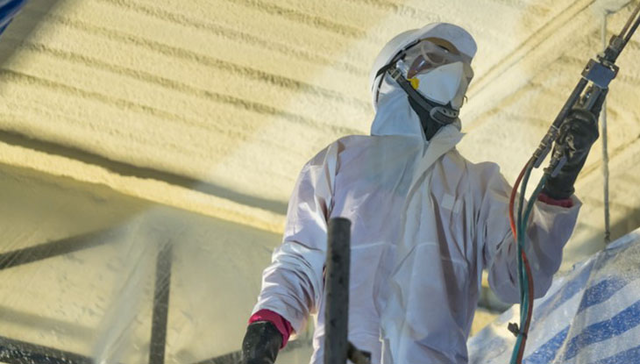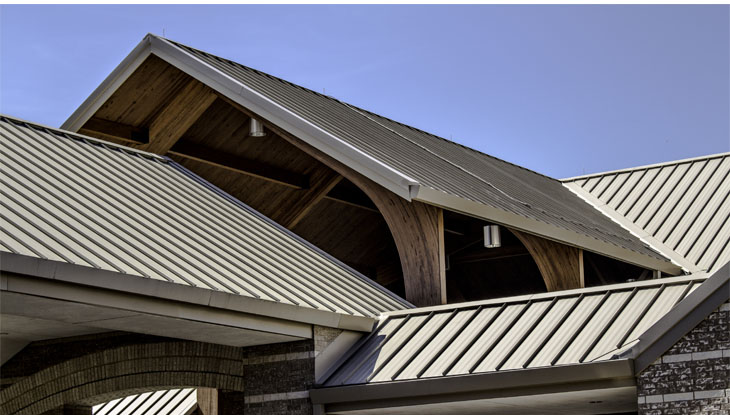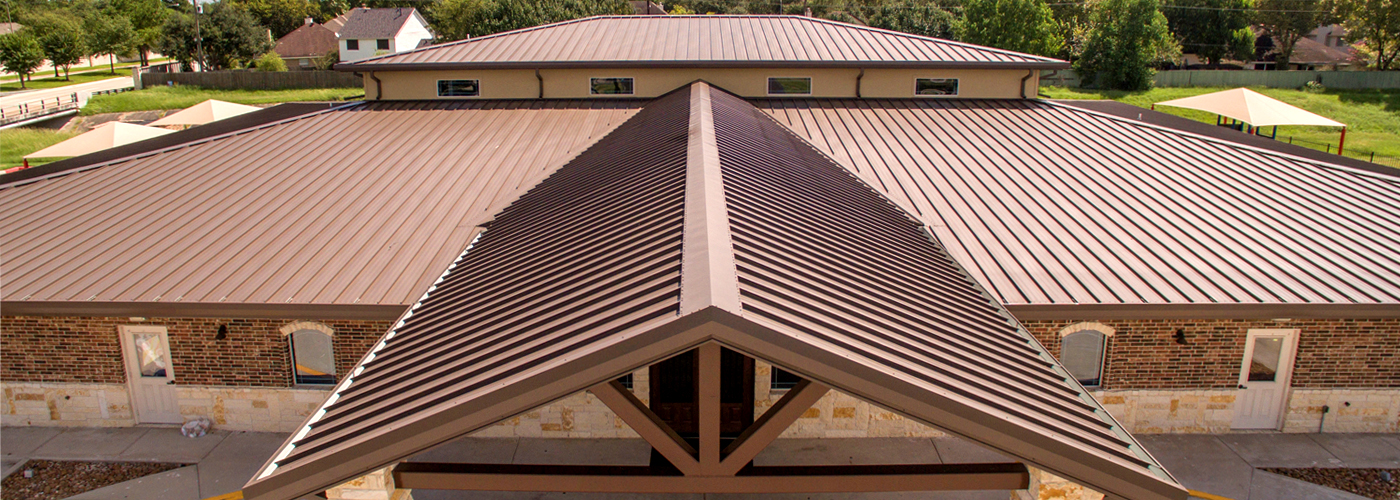Pre-painted Metal






The building is designed. The construction schedule is worked out. The materials have been chosen. The trades have been hired. There’s just one more crucial decision to make: The finish.
Metal construction with MBCI already has a long list of benefits basically built in, from enhanced sustainability to superior durability and longevity. But to ensure the long-term, high-performing life of the MBCI materials you’ve invested in, you also need to choose the right finish for your metal components.
Though many people think of finish as simply the color on top of the metal, it’s actually far more. Standard finishes include a primer designed to bind the colorcoat to the metal substrate and provides additional corrosion protection. The colorcoat is comprised of a resin and pigments to create a durable finish in a variety of colors. MBCI’s color finishes are composed of a combination of layers and ingredients to provide you with the best technology for your specific project. MBCI can provide customized finishes that can include additional layers of primer, colorcoat or topcoats depending on the level of protection you choose. The selected resins, pigments and other ingredients determine not only the color and gloss, but how well the finish can stand up to the elements, its expected longevity – and therefore the lifetime of the material it’s protecting.
MBCI offers two categories of standard finishes. The Signature® 200 series of coatings is a silicone modified polyester (also known as SMP). Silicone modified polyester coatings are hard, durable finishes that provide remarkable gloss, color retention and chalk resistance. A perfect choice for doors, wall cladding, agricultural and high traffic commercial projects. The most economical choice, Signature® 200, comes in a variety of stock colors and can also be customized to your specifications.
For premium projects or projects in more aggressive environments, MBCI’s Signature® 300 series of coatings utilize a 70%polyvinylidene fluoride (PVDF) resin. PVDF finishes offer superior color retention and are highly resistant to harsh conditions such as UV radiation, high winds, high altitudes, acid rain, high humidity and other chemically or environmentally aggressive environments. Signature® 300 coatings are perfect for high visibility architectural and industrial projects. If you’re building near the coastline, MBCI carries a special finish formulated to stand up to marine environments and damaging salt spray.
MBCI also provides customized finishes for interior projects wherever corrosive conditions occur indoors, such as in water treatment plants, indoor swimming pools or facilities that use or manufacture caustic, corrosive chemicals.
The popular reds and greens of recent decades have given way to trends toward more natural colors, earth tones, calming blues and natural metallics such as copper and bronze. As MBCI Paint and Coatings Specialist Martin Thompson explains, “MBCI’s stock color options reflect the changes in color trends – and if there is something we don’t offer on the standard color chart, we will customize it for you.”
You can download MBCI’s Color Charts here:
Commercial & Industrial Color Chart
If you don’t find the option you had in mind, contact your friendly MBCI representative to start the color customization process. We can match virtually any shade, but custom colors may require increased lead time.
Once you’ve completed a project, you’ll certainly want to maintain it. While MBCI products require little to no maintenance, there are a few pointers that will help get the longest life and best performance out of your MBCI metal finish:
We know our finishes are strong, and we stand by them. Both the Signature® 200 and Signature® 300 series come with 30-year colorfastness and 40-year film integrity warranties. Colorfastness refers to the color maintaining its appearance, while film integrity is an indicator of how long the finish will adhere to the panel surface. In exceptionally harsh environments such as heavy industrial or coastal areas, the warranty may be different. Speak to your representative for more details. In case of small scratches or blemishes, touchup paint matching your finish is available through MBCI.
When you’re ready to make decisions on coatings and finishes – or if you just have questions – don’t hesitate to reach out to your MBCI representative.
Metal panels need attention; they should not be taken for granted. True, they are a notably long-lasting and attractive choice, particularly with the myriad colors and protective finishes available, but once installed, proper care is imperative in order to maintain their durability, performance and good looks for decades.
What are the main culprits of potential damage? Dirt and residue (such as from trees or animals) left to sit on metal panels, for instance, can cause the irreversible degradation of protective coatings, thereby compromising the longevity of roof and/or wall systems. Additionally, corrosive elements, including bacteria, mold, mildew or even acid rain can damage the structural integrity of the panels. Additionally, buildup of foreign elements, such as leaves, can hide potential leak areas or places that may be rotting away. Even in terms of energy efficiency, keeping the panels clean may help a roof reflect heat as they were originally intended.
To keep panel appearance in top shape, protecting the finishes must be a priority—otherwise, you may find yourself needing to re-coat the panels. Stains from leaves and moisture, algae and lime deposits that remain on panels for extended periods can do serious harm to the finish. It should be noted, however, that re-coating should only be considered if the panels remain structurally sound and if doing so wouldn’t void the manufacturer warranty.
How often should you clean metal panels? Most experts agree that at a minimum, an annual cleaning is advisable in order to keep the panels free of common elements that can jeopardize the integrity of the finishes. If you have heavy tree overhang, you may need to clean it or remove debris a little more frequently.
Deep cleaning to remove more stubborn substances (e.g., tree sap, oxidation) can be done every 3 to 5 years, depending on the building conditions, location and weather, etc. Interim, moderate cleanings can also be performed following substantial weather events and seasonal allergen build-up. It’s a good idea, in fact, to assess roof conditions before winter hits to identify any potential issues that need to be addressed.
No matter the frequency, perhaps the most important advisory when it comes to cleaning the panels is to follow the panel manufacturer’s recommendations regarding who should perform the work and with what solutions and tools so as not to void any warranties. In some instances, it may be beneficial (or perhaps even required) to have a professional building surface cleaning company with metal panel experience do the work.
As for the maintenance and cleaning instructions, it’s always best to refer to the manufacturer’s guidelines in order to best protect specific products, for example, to determine which cleaning solutions and techniques work best for a given manufacturer’s panels. Neglect or improper care can degrade the finish, compromising not only the visual appearance and performance but, as noted, can also potentially void the panel warranty. But maintaining the panels doesn’t just entail washing them like you would a car; it also means keeping them free of harmful debris.
Here are a few general tips for the proper cleaning of metal panels (again, refer to the panel manufacturer’s specific directions):
Simple cleaning: generally, water and mild detergent will be sufficient. Do NOT use bleach, which can change the finish color or have a harmful interaction with certain finishes.
Water-soluble dirt or other deposits requiring more complete cleaning: you can use a solution of hot or cold water mixed with detergent. In a container of water, use a 5 percent solution of commonly used commercial (non-industrial, non-bleach) mild detergent. Use a cloth or a soft-bristle brush for application of the cleaning solution, followed by a clean water rinse. Alternatively, pressure-washing with a 40° tip is also an option.
Non-water-soluble deposits such as tar, grease, oil and adhesives: a solvent or alcohol-based cleaner may be required. In this case, since most organic solvents are flammable and/or toxic, they must be handled accordingly. Generally, keep them away from open flames, sparks and electrical motors; use adequate ventilation, protective clothing and goggles; and read the manufacturer’s Material Safety Data Sheet (MSDS) of any solvent used for any other specific safety details.
The following are among the cleaners widely recognized by manufacturers for this type of non-water-soluble cleaning: alcohols—denatured alcohol (ethanol) and isopropyl alcohol (rubbing alcohol); and solvents, including VM&P Naphtha, mineral spirits, kerosene, and turpentine (wood or gum spirits).
For any level of cleaning, do NOT use wire brushes, abrasives, or similar tools that will erode the surface coating and leave scratches or other finish damage that can lead to corrosion. Additionally, always test a small area before proceeding with any of the cleaning agents mentioned to ensure there is no adverse effect resulting from the product’s use.
Remember, the misuse or abuse of any of the acceptable cleaning agents will automatically void any manufacturer’s warranty for the affected surfaces, so be sure to check with the manufacturer and also follow directions on any cleaning products used.
By following the tips above, installers can keep metal panels looking great and performing well for years to come.
To learn more about the importance of cleaning metal panels, contact your MBCI representative or check out our blog post on metal panel maintenance.

Agricultural applications need building solutions that are durable, effective, cost-efficient and versatile, which is why MBCI’s high-quality metal building products undergo rigorous testing to ensure they will meet or exceed the aesthetic and structural requirements of any agricultural building initiative—from general farm facilities to barns, pole barns, sheds, horse stables, riding arenas, ranches, livestock stables, crop storage buildings, machinery storage and garages, animal shelters and more.
Metal is an excellent choice for agricultural applications because of its durability and longevity, ease of installation on new or existing buildings, its ability to provide a weathertight seal and its low maintenance requirements.
The lifespan of metal roofs and siding can be up to 60+ years. MBCI’s metal panels are built with high-quality material and are backed by some of the industry’s leading warranties. Durable and low-maintenance agricultural steel panels are a perfect fit for the demanding nature of farm and ranch buildings, offering resistance and strength under extreme temperatures, high winds, heavy snowfall, strong storms and other harsh weather conditions. In fact, during hot summers, metal panels can help keep your building cool and energy costs low, while in the winter they shed ice and water to prevent damage. Metal, indeed, has a distinct advantage in its ability withstand the elements and not rot or warp over time.
MBCI’s agricultural metal roof and wall panels are also sustainable—made from recycled materials and are 100% recyclable at the end of the building’s life.
As far as design options go, you can choose from a variety of styles, profiles and colors for your metal barn siding, pole barn siding, metal shed roofing and more. Exposed fastener panels are the most commonly used on agricultural buildings because of their economical pricing and durability. MBCI offers up to 10 different exposed fastened panel profiles to choose from, depending on your preference and the region you’re in. Examples include: Rain Guard®, Perma-Clad®, WeatherSafe®, and Stormproof®, which can be used with DripStop technology to control condensation.
Once you’ve made the decision to use metal for your agricultural building, determining the particulars will depend on a number of factors. Here are some preliminary questions to consider.
As far as aesthetics, metal panels come in a multitude of colors (MBCI offer approximately 25 color options), so you have a lot of versatility with the color scheme for your agricultural project. Traditionally, what we see is a single color for the roof panels and then an alternate color on the walls, and the trim typically matches the roof panel. Another trend is a wainscot panel or a designer panel, which is basically a smaller strip around the base of the building to add an accent color. From there, many customers will wrap that with stone or masonry, too, to make it more decorative. Plus, with the merger of MBCI’s parent company with Ply Gem, our customers now have access to stone products as well.
Metal building options don’t end with roof and wall panels. To that point, MBCI prides itself on being a complete building envelope solution. If a steel frame building is your desire, then MBCI has that covered as well. From new construction to repair and remodel, MBCI offers a vast line of primary and secondary steel structural products and resources to meet the project’s needs. MBCI also partners with many great customers nationwide to offer componentized steel structures that can benefit any agricultural application.
Additionally, with the recent Ply Gem merger previously mentioned, MBCI is better positioned to give customers access to windows, walk doors, stone, and many other components needed to further enhance agricultural projects—all from a single source supplier.
Whether you need a complete structure, metal roof or wall panels, or simply components for a repair or addition, MBCI has the right products and accessories to meet any agricultural building requirement.
For information about MBCI’s agricultural metal building products and solutions, contact your local sales representative.
Whether it is wind speed, sun exposure or the proximity to a coastline, these factors would be the major considerations when choosing metal roofing for a project in coastal areas. The good news is that metal panels can be used in just about any coastal area so long as you find the right product profile and finish that meets your specific requirements to maximize performance given the variables of the environment.
There are a number of special considerations given the environmental conditions inherent to a coastal area, including the impact to paint systems and certain unique maintenance requirements, wind ratings, hurricane conditions and certifications/regulatory product approvals that will limit the panels you can you use within specific coastal areas, for instance Dade County, the state of Florida, and the Texas Coast.
Metal components can be a great roofing choice, even in a coastal area, whether a bay, gulf, or ocean water. Key is how you manage the finish on the products and how close you are to the actual salt environment. Simply stated, if you’re outside of a 1,500-foot range from the coastline or salt water, then standard metal roofing would be suitable, but if you’re closer to the coastline there are special paint options or finishes you’d need for the product to withstand the coastal environment.
At MBCI, we use Flurothane Coastal coil coating system* as our standard solution to the challenge of salt spray and harsh coastal environments. This coating is a premium fluoropolymer (PVDF) system developed for use in the most extreme coastal environments. This system is unique in its use of an innovative thick film primer. The two-coat system has a total dry film thickness (DFT) of 1.7 to 2.0 mils.
Choosing an appropriate coastal finish can also affect your product’s warranty. If, for example, your project is within the 1,500-foot range and you don’t choose the required coastal finish, if the panels were to rust there would be no warranty offered and it could affect your warranty for weathertightness as well.
Overall, roof failures are the largest hurricane loss due to wind and water damage. For this reason, metal roofing is a highly recommended option for coastal regions where hurricanes and high force winds are prevalent. The appropriate metal panel type for these areas is mainly contingent upon what you want to accomplish. Because MBCI does have high wind ratings for most of our panels, whether it be a screw down (aka through-fastened) panel or a standing seam profile panel, selections should be determined by the complexity of the roof itself and the roof conditions. There are standing seam panels and through-fastened panels that can be approved for both roof and wall applications in many coastal areas.
Also, of note, different types of coastal areas may receive higher wind speeds. There is obviously a wide difference in wind speeds between the East Coast and the West Coast, for example, although both are coastal communities. In an area with higher wind speeds and/or hurricane conditions, you would want to consider panels that achieve higher wind ratings. Since there are many different panel options, and some may not be able to achieve as high wind ratings as others, you should look at what those values would be for wind and what testing has been done. MBCI’s metal wall panels and roofing systems are able to resist and withstand extreme environmental conditions, such as those in Florida or the Texas coast where strict product approval and testing processes are required.
MBCI has panels that meet requirements for Florida Approval, Dade County and Broward County for instance, where you need to have an NOA (Notice of Acceptance) for those county areas, as well as products that are TDI approved (Texas Department of Insurance), which is usually seen in the Texas coastal area.
Additionally, sun exposure and color can have an impact as far as solar reflectance, so that is another consideration. Somewhere like Florida gets a lot of sun yet a coastal area in Washington State would be mostly cloudy. If you are in an area that has more sun, then you may want to consider a panel with a higher solar reflectance value.
If you have metal roofing in a coastal area, you’re going to follow much of the same maintenance as you would on any metal roof, but you would want to inspect it for damage, especially after a wind event or storms. One of the main differences, though, especially if you’re within the 1,500-foot limit where you needed a special finish, is that you’re going to have to do a fresh water rinse regularly on the panels a couple of times a year. What this means is you are basically hosing it off with fresh water to get the potentially corrosive salt spray residue off of it.
For more on metal roof and wall panels and finishes for use in coastal areas, contact your local MBCI representative.
* (1) All substrates must be properly pretreated. (2) American Society for Testing and Materials. (3) Flurothane Coastal system is not designed to bridge cracks in the substrate. (4) Varies by color. (5) Flurothane Coastal system will generally meet the requirements for most post-painted fabrication processes. However, variations in metal quality, thickness or cleaning/pretreatment applications can lead to diminished flexibility.
SOURCE: Valspar Corporation